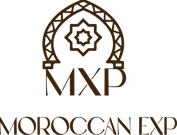Timeless Moroccan Leathercraft | Moroccanexp
7 min read


Introduction to Moroccan Leathercraft
The tradition of leathercraft in Morocco is a deeply rooted aspect of the country’s cultural heritage, reflecting centuries of artisanal skill and technique. Renowned for its exceptional quality and durability, Moroccan leather has become synonymous with luxury and sophistication. The craft is not merely a trade; it embodies a rich history that spans numerous generations, steeped in local customs and practices that have been meticulously preserved over time.
Morocco's diverse geography, particularly the rugged Atlas Mountains, significantly influences the leather production process. The country's unique climate and natural resources offer ideal conditions for breeding livestock, primarily sheep and goats, that provide high-quality hides. Artisans leverage these natural assets, skillfully transforming raw materials into beautifully crafted leather goods. From traditional bags and shoes to intricate decorative items, Moroccan leather products showcase the remarkable ability of artisans to blend utility with aesthetic appeal.
This age-old craft involves a series of specialized techniques, including tanning, dyeing, and stitching, often passed down within families. The use of natural tanning methods, combined with vibrant dyes derived from local plants, contributes to the distinctive character and quality of Moroccan leather. Each piece is a testament to the craftsmanship and dedication of the artisans, as they meticulously create items that are both functional and works of art.
Today, the reputation of Moroccan leathercraft continues to thrive, attracting enthusiasts and collectors from around the globe. This enduring legacy not only serves as a means of livelihood for many artisans but also reinforces the cultural identity of Morocco. As one delves deeper into the world of Moroccan leathercraft, one uncovers a complex interplay of tradition, artistry, and nature, all vital in crafting this timeless art form.
The Role of the Atlas Mountains in Leather Tanning
The Atlas Mountains, a majestic range spanning Morocco, offer not only breathtaking landscapes but also serve as a vital resource for the country’s leather industry. These mountains are characterized by their unique biodiversity, housing various flora that are instrumental in the traditional methods of leather tanning. The presence of natural tannins derived from local plants such as oak and mimosa plays a critical role in enhancing the quality and durability of the leather produced in this region.
The tanning process in the Atlas Mountains is steeped in tradition, relying on centuries-old techniques that emphasize sustainable practices. Artisans utilize the tannins sourced from the native vegetation, which ensures a product that is both environmentally friendly and robust. This eco-conscious approach not only supports the local ecosystem but also promotes the use of renewable resources, showcasing the artisans’ commitment to protecting their natural surroundings.
The Art of Vegetable-Dyed Leather
The process of vegetable dyeing is a revered tradition within Moroccan leathercraft, showcasing the intricate artistry that has been passed down through generations. This method employs natural materials, including plant-based ingredients such as tree bark, fruits, and leaves, to create vivid hues that reflect the rich landscape of Morocco. Artisans meticulously combine these organic elements, demonstrating an unparalleled understanding of how they interact to yield an array of colors—from deep browns to vibrant reds and earthy yellows.
The advantage of vegetable dyeing extends beyond its aesthetic appeal. Unlike synthetic dyes, which often contain harmful chemicals, natural dyes are eco-friendly and biodegradable. As environmental consciousness grows, the demand for sustainable practices in fashion and textiles has surged. Vegetable-dyed leather not only minimizes harmful waste but also supports a cultural legacy that advocates for the responsible use of resources. Each dyed hide embodies a commitment to preserving traditional techniques while aligning with modern sustainability values.
The enduring legacy of Moroccan leathercraft, particularly through the lens of vegetable dyeing, highlights a commitment to artistry, sustainability, and a harmonious relationship with the environment. By choosing vegetable-dyed leather, consumers not only invest in a premium product but also participate in a significant cultural and ecological narrative, embracing a future where craftsmanship and environmental considerations are paramount.
A Celebration of Moroccan Artisanship
The art of leathercraft in Morocco is a testament to the exceptional skills and dedication of its artisans, who have meticulously honed their craft over generations. This longstanding tradition reflects a deep connection between the artisans and the natural resources of the land. With each piece of leather, these skilled craftsmen breathe life into their creations, embodying both artistry and functionality. The intricate techniques involved in crafting leather goods, ranging from bags to footwear, illustrate a rich cultural heritage that is both vibrant and enduring.
Moroccan artisans employ a variety of traditional methods to transform raw leather into exquisite products. The tools of their trade are often simple, yet effective, enabling them to produce high-quality goods through manual techniques that have been passed down through families. Each item is made with care, showcasing the artisan's personal touch and attention to detail. For instance, hand-stitching techniques create a unique finish that differentiates handmade items from those produced in factories. The process frequently involves intricate designs, which are inspired by Moroccan culture and history, adding character and uniqueness to each piece.
This artisanal approach starkly contrasts with mass production methods, which often prioritize efficiency and uniformity over individuality and craftsmanship. While factory-made goods tend to lack the soul and story embedded in handmade items, Moroccan leathercraft shines as a symbol of authentic artisanry. Customers who opt for these unique products not only acquire beautifully made items but also support the preservation of a time-honored craft, ensuring that the skills and traditions of Moroccan artisans continue to thrive. This dedication to quality and craftsmanship is what makes Moroccan leather goods particularly cherished on both local and international stages.
The Impact of Global Demand on Moroccan Leather
The global demand for Moroccan leather products has surged in recent years, leading to profound implications for the country's artisans and their time-honored craft. As various international markets express increasing interest in high-quality leather goods, Moroccan artisans are presented with both opportunities and challenges. On one hand, this demand provides a viable pathway for many artisans to expand their businesses and reach a broader audience, generating much-needed income and contributing to the local economy.
However, navigating this global interest is not without its difficulties. The pressure to meet international standards can jeopardize the authenticity of traditional leathercraft techniques that have been passed down through generations. Artisans often find themselves in a position where they must balance preserving their rich cultural heritage with the need to adapt to modern consumer preferences and trends. This dynamic can lead to the incorporation of new materials or production methods that may detract from the original essence of Moroccan leathercraft.
Moreover, the increased focus on sustainability has added another layer of complexity to the situation. Buyers worldwide are increasingly conscious of the environmental implications of their purchasing decisions. As a result, Moroccan artisans are challenged to maintain the quality of their products while implementing sustainable practices in sourcing and production. Promoting eco-friendly methods can enhance the appeal of Moroccan leather products in the global marketplace but also requires investment and adaptation.
In conclusion, the impact of global demand on Moroccan leather presents a nuanced landscape for local artisans. While the surge in interest offers lucrative opportunities, it necessitates a careful approach to balance modernization with the preservation of traditional craftsmanship, ensuring that the legacy of Moroccan leather endures through time.
Why Moroccan Leather Outshines Mass Production
Moroccan leather, renowned for its exceptional craftsmanship, stands in stark contrast to mass-produced alternatives. The uniqueness of each piece is attributed not only to the skill of the artisan but also to the quality of materials sourced from the local environment. The tanning process used in Morocco, often employing natural ingredients such as tree bark and oils, results in leather that is not only durable but also rich in character. This method of production greatly enhances the leather's longevity and ensures that it ages beautifully over time, unlike synthetic counterparts that may wear out quickly.
Aesthetically, Moroccan leather is distinguished by its rich hues and intricate designs. Artisans often incorporate traditional motifs and embroidery, making each item a unique piece of art. The vibrant colors and supple feel of Moroccan leather contribute to its appeal, allowing consumers to choose items that resonate with their personal style. This artistic approach to leathercraft evokes a sense of authenticity that mass-produced goods simply cannot replicate, which often rely on uniform designs and cheaper materials that lack individuality.
In today’s consumer landscape, values such as sustainability and authenticity are gaining precedence among buyers. Many consumers are increasingly aware of the environmental impact of mass production and are opting for handcrafted goods that support both the artisan community and eco-friendly practices. By choosing Moroccan leather, individuals are not only investing in high-quality products but also in the stories and traditions behind them. Each handcrafted piece reflects hours of labor, cultural heritage, and sustainable practices, making it more than just a product; it is a symbol of artistry and ethical consumption. The choice of Moroccan leather therefore goes beyond mere aesthetics, aligning with the values of those seeking to make thoughtful purchasing decisions in an age of fast fashion.
Conclusion: Embracing the Leathercraft Legacy
As we reflect on the rich tapestry of Moroccan leathercraft, it becomes clear that this artisanal tradition embodies more than just skilled craftsmanship; it represents a deep connection between people and nature. The enduring appeal of Moroccan leather products lies in their unique blend of cultural heritage and remarkable artistry, which continues to capture the interest of contemporary consumers seeking authenticity and quality in their purchases. As the demand for artisanal products grows, it presents an opportunity for individuals to appreciate the profound stories that each handmade piece tells.
Supporting local artisans is not merely a gesture; it is a commitment to sustainability and the preservation of traditional techniques. Moroccan leathercraft relies on methods passed down through generations, often utilizing natural materials and environmentally mindful processes. By choosing to invest in handcrafted leather items, consumers are championing an ethical approach to luxury that values the labor and creativity of skilled artisans over mass-produced alternatives. This shift in consumer behavior towards sustainable luxury is crucial for ensuring that these time-honored traditions endure for future generations.
The diversity of Moroccan leather products also presents a tantalizing invitation to explore the vast array of styles and functions. From intricately designed bags and belts to intricately embossed shoes and home décor items, each piece serves as a testament to the artisan's dedication to their craft. In embracing the legacy of Moroccan leather, one not only acquires a unique product but also partakes in a journey that honors the intricate bond between craftsmanship and culture. As you consider your next purchase, let it be an expression of respect for the artisans and the rich tradition that is Moroccan leathercraft.
Discover our luxurious bags and women's apparel
Contact us:
© 2025. All rights reserved
Partners




